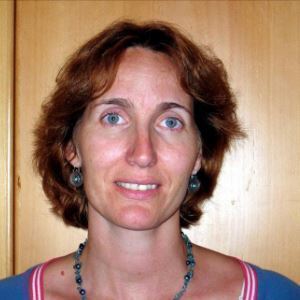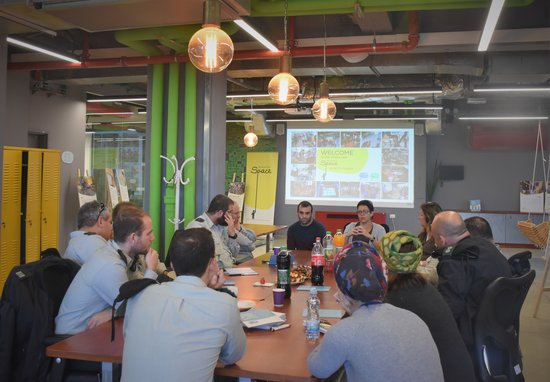IDF Tank Development team with Maurit Beeri
On a blustery February Jerusalem morning, a surprising group assembled at the ALYN Pediatric Rehabilitation Hospital. The entire IDF’s Tank Development Authority listened to an occupational therapist who presented them with a technical challenge that would one day make a difference not in the desert, but in the battlefield of the daily life of a child in a powered wheelchair. After meeting parents and children undergoing rehabilitation, some of whom are respirator-dependent, the high-ranking engineers plan to volunteer their unit’s exceptional know-how and problem-solving skills to tasks outside of their comfort zone.
This unexpected meeting is an outcome of the newly established Wexner Israel Innovation Forum, bringing together Wexner Israel programs alumni from every corner of Israeli leadership in order to create a network of shared knowledge and cooperation. Several weeks ago, the Forum met at ALYN Hospital to discuss how to use Design Thinking to problem solve the application of new technologies in the treatment of children.
It is no wonder that there is a need for innovative thinking when the issue is children with special needs. Rehabilitating children presents special challenges, but also unique opportunities. Trying to rehabilitate a child is like trying to score points in a quaking stadium with the goalposts constantly shifting. In contrast to adult rehabilitation, where after an injury or illness the therapy aims to return the person to her or his previous functioning, pediatric rehabilitation must advance a developing child along the ongoing road of physical, emotional, psychological and social development. For rehabilitation to succeed, these milestones must match the child's age. In a pediatric hospital such as ALYN in Jerusalem, work and therapy are aimed at where a child should be rather than where they once were.
Therapy for children must also be fun in order to be effective. Play is a child’s work, and play has never been more data-driven than in the current era of technology-based entertainment and gaming. Today’s children are "digital natives" who master software-based devices intuitively; in fact, they may be more abled in their ability to assimilate new technologies than their adult caregivers, who are digital immigrants. However, the off-the-shelf market-ready products are rarely adaptable to their specific limitations and needs. Thus, children with disabilities attempting to participate in age-appropriate activities fail due to the lack of accessibility. Participation in social activities, friendship and fun are key elements in the successful integration of young people into society. The opportunity of bridging these gaps is one aspect of ALYN’s innovating work.
Other ongoing challenges of pediatric rehabilitation include the cost, availability and suitability of assistive devices for children who need them. Children come in many different shapes and sizes and are all constantly growing and developing, both physically and in terms of their participation in educational and leisure activities. This means that the devices they use must be available in a wide variety of sizes and must be replaced or re-scaled at regular intervals. In contrast, comparable technologies for adults have a longer shelf-life and can be mass produced in standard sizes for a larger patient population, and at less cost. To date, most assistive devices have been designed and produced for adults, while there is a lack of innovative technologies and affordable devices customized for children. The result is that millions of children around the world are denied access to the assistive technologies that are available to adults in their societies, even though children bear a higher potential for overcoming initial injury than adults. These children are at risk for growing up isolated from society, unable to integrate into educational frameworks and incapable of later supporting themselves as adults.
Lately, we do see a societal shift. Large corporations are ready to adapt their products as the concept of "Inclusive Design" begins to take hold by incorporating features that are meant to assist people with accessibility needs into regular market products. To a certain extent, this reflects some societal acceptance of being differently-abled as just another rung on the ladder of human diversity. We like to think of it as an aspect of Tikun Olam.
At ALYN Hospital in Jerusalem, we have taken it upon ourselves to look to the future and ensure the best possible outcome for these children. This is a labor-intensive undertaking requiring comprehensive and ongoing case-management and a high degree of cooperation between multiple caregivers and institutions. Early and intensive investment in innovative childhood development and rehabilitation services incurs a high and immediate price tag and the return will only be realized years down the road. Nonetheless, every developmental step toward maximal participation in society that a child takes early on helps build a future of lifelong independence and improved well-being for that child. This, in turn, will translate into reduced future healthcare costs along with a healthier and happier lifestyle for us all.
ALYN's Innovation Space makes dreams a reality: we assess and develop an eclectic assortment of technologies to help motivate children and access their inner and external worlds. These techniques include advanced alternative and augmented communication technologies such as eye-tracking devices for operating digital communication platforms, powered wheelchair mobility using a wide variety of adaptive switches and levers, virtual reality games and advanced 3D motion-analysis sensors and software for analyzing gait and limb movement in order to develop guidelines for splinting and orthopedic surgery.
In order to realize our dream, we came up with the notion of creating an Innovation Space for developing assistive technologies for children. ALYN Hospital turned to the National Social Funds for assistance and coincidentally, five out of the seven participants in the kick-off meeting were Wexner Israel Alumni, making the project a Wexner alumni infused program from the get-go.
Last week, four years after the kick-off meeting that started it all, it was the ALYN Innovation Space's privilege to host The Wexner Innovation Forum. The Forum brings together Wexner alumni from different fields, all interested in change and development, to meet, network and learn from each other. We were happy to showcase ALYN's ground-breaking innovations for the benefit of wider world and for the individual patient. An example of the former is the inexpensive but life-changing designed-to-cost Wheelchairs of Hope mobility solution, already being used in 22 countries. An example of our individualized products are our only-in-Israel Halacha-compatible solutions, such as a reader for a respirator-dependent young woman who uses a tablet to read but needed a Shabbat appropriate device or the unique product built to help a 13 year-old bar-mitzvah to don his head tefillin independently.
The group dedicated its first meetings, including the one at ALYN, to understanding the concept of the Design Thinking. Beyond the discussion and learning process, the Innovation Forum's networking proved immediately impactful: barely two weeks after hosting the Forum at ALYN, Wexner Israel Fellow Alum Eli Hotovely (Class 30), Deputy Head of the Tank Development Authority in the IDF, led his whole unit into ALYN for mutual brainstorming, from which we believe some incredible new assistive devices may be created. One of the challenges his team of top engineers and designers faced include the development of facial-recognition software that will alert parents when a child on a respirator is crying despite no sound being heard. Another will seamlessly update alternative communication programs so that children who communicate through eye-tracking computer software can have fluent discussions with their peers.
“Design Thinking” is only one theory explored by the Wexner Innovation Forum, and the meeting between the ALYN staff and the IDF’s Tank Authority is only one aspect of the cross-boundary fertilization that a community of innovative leadership can foster. We hope to update our Wexner community in some outstanding results of this forum’s activity soon.
We do not yet know what these ideas might bring to the table, but we know from experience that inventions that started as solutions for people with disabilities have transformed the lives of able-bodied people as well. Giuseppe Pellegrino Turri created the first working typewriter in the beginning of the 19th century for a friend who was losing her vision; Alexander Graham Bell began researching what became the first telephone while trying to find solutions for his hearing-impaired mother and wife. Who knows what life-changing gadgets could develop out of this interesting meeting of minds?



Get To Know The Authors
WIF Alum Maurit Beeri, M.D. (Class 20) serves as Director General of the ALYN Pediatric and Adolescent Rehabilitation Center in Jerusalem.
WIF Alum Naomi Gefen (Class 19) is the Deputy Director General for Clinical Services in ALYN Hospital.
.jpg) Hilla Boral is the Director of the ALYNnovation Center. She is also the spouse of WIF Alum Ra'anan Boral (Class 7).
Hilla Boral is the Director of the ALYNnovation Center. She is also the spouse of WIF Alum Ra'anan Boral (Class 7).

